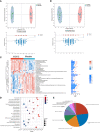The therapeutic role and potential mechanism of EGCG in obesity-related precocious puberty as determined by integrated metabolomics and network pharmacology
- PMID: 37334310
- PMCID: PMC10272822
- DOI: 10.3389/fendo.2023.1159657
The therapeutic role and potential mechanism of EGCG in obesity-related precocious puberty as determined by integrated metabolomics and network pharmacology
Abstract
Objective: (-)-Epigallocatechin-3-gallate (EGCG) has preventive effects on obesity-related precocious puberty, but its underlying mechanism remains unclear. The aim of this study was to integrate metabolomics and network pharmacology to reveal the mechanism of EGCG in the prevention of obesity-related precocious puberty.
Materials and methods: A high-performance liquid chromatography-electrospray ionization ion-trap tandem mass spectrometry (LC-ESI-MS/MS) was used to analyze the impact of EGCG on serum metabolomics and associated metabolic pathways in a randomized controlled trial. Twelve weeks of EGCG capsules were given to obese girls in this trail. Additionally, the targets and pathways of EGCG in preventing obesity-related precocious puberty network pharmacology were predicted using network pharmacology. Finally, the mechanism of EGCG prevention of obesity-related precocious puberty was elucidated through integrated metabolomics and network pharmacology.
Results: Serum metabolomics screened 234 endogenous differential metabolites, and network pharmacology identified a total of 153 common targets. These metabolites and targets mainly enrichment pathways involving endocrine-related pathways (estrogen signaling pathway, insulin resistance, and insulin secretion), and signal transduction (PI3K-Akt, MAPK, and Jak-STAT signaling pathways). The integrated metabolomics and network pharmacology indicated that AKT1, EGFR, ESR1, STAT3, IGF1, and MAPK1 may be key targets for EGCG in preventing obesity-related precocious puberty.
Conclusion: EGCG may contribute to preventing obesity-related precocious puberty through targets such as AKT1, EGFR, ESR1, STAT3, IGF1, and MAPK1 and multiple signaling pathways, including the estrogen, PI3K-Akt, MAPK, and Jak-STAT pathways. This study provided a theoretical foundation for future research.
Keywords: EGCG; metabolomics; network pharmacology; obesity; precocious puberty.
Copyright © 2023 Gu, Xia, Du, Shao, He, Wu, Liang and Shen.
Conflict of interest statement
The authors declare that the research was conducted in the absence of any commercial or financial relationships that could be construed as a potential conflict of interest.
Figures






References
-
- De Sanctis V, Soliman AT, Di Maio S, Soliman N, Elsedfy H. Long-term effects and significant adverse drug reactions (ADRs) associated with the use of gonadotropin-releasing hormone analogs (GnRHa) for central precocious puberty: a brief review of literature. Acta BioMed (2019) 90:345–59. doi: 10.23750/abm.v90i3.8736 - DOI - PMC - PubMed
Publication types
MeSH terms
Substances
LinkOut - more resources
Full Text Sources
Research Materials
Miscellaneous

